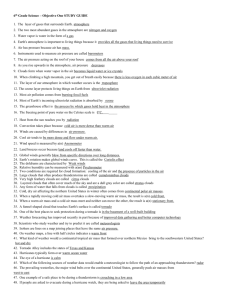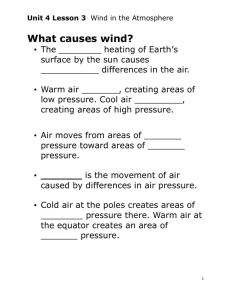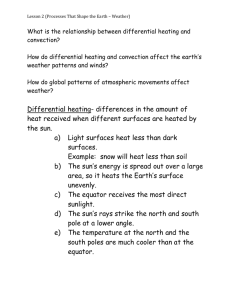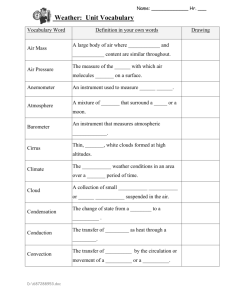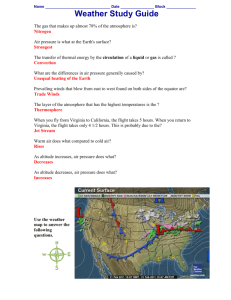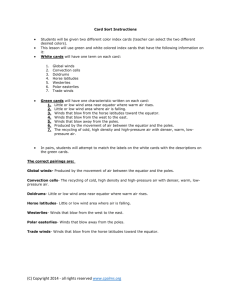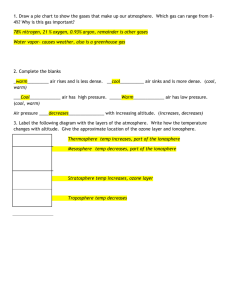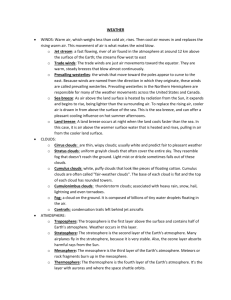File - Fifth Grade!
advertisement
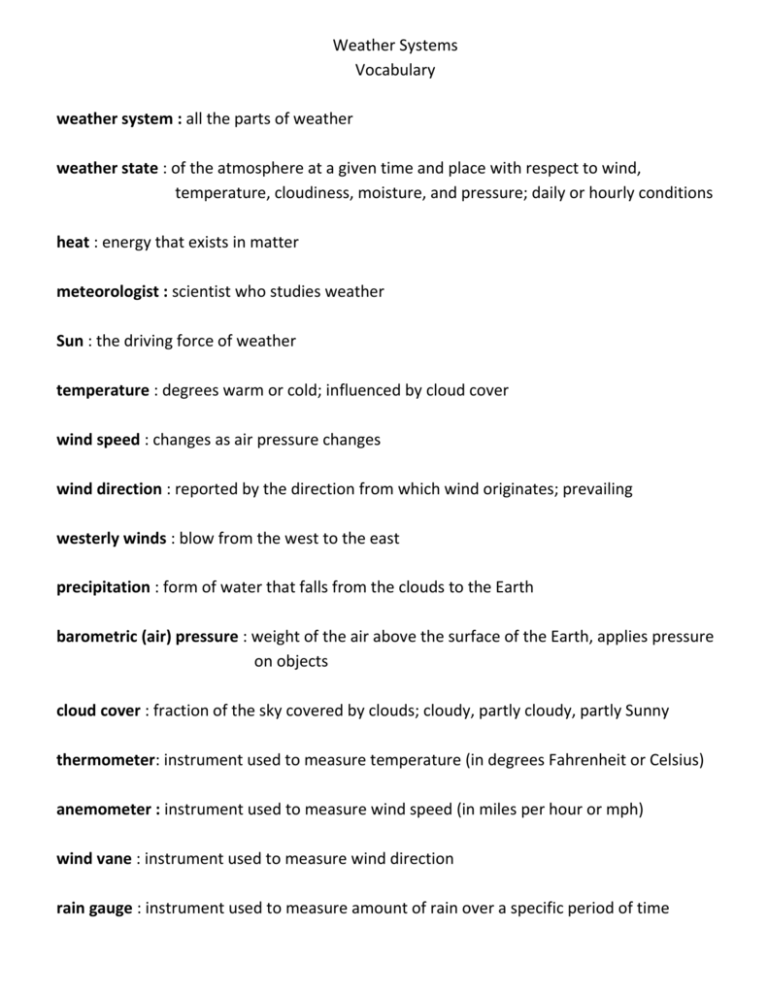
Weather Systems Vocabulary weather system : all the parts of weather weather state : of the atmosphere at a given time and place with respect to wind, temperature, cloudiness, moisture, and pressure; daily or hourly conditions heat : energy that exists in matter meteorologist : scientist who studies weather Sun : the driving force of weather temperature : degrees warm or cold; influenced by cloud cover wind speed : changes as air pressure changes wind direction : reported by the direction from which wind originates; prevailing westerly winds : blow from the west to the east precipitation : form of water that falls from the clouds to the Earth barometric (air) pressure : weight of the air above the surface of the Earth, applies pressure on objects cloud cover : fraction of the sky covered by clouds; cloudy, partly cloudy, partly Sunny thermometer: instrument used to measure temperature (in degrees Fahrenheit or Celsius) anemometer : instrument used to measure wind speed (in miles per hour or mph) wind vane : instrument used to measure wind direction rain gauge : instrument used to measure amount of rain over a specific period of time barometer : instrument used to measure air pressure data : information (plural; singular = datum) hemisphere : half of a sphere; the Earth has four hemispheres: northern, southern, eastern, western; the Equator divides the Earth into the northern and southern hemispheres and the Prime Meridian divides the Earth into the Eastern and Western hemispheres. Equator : Imaginary, horizontal line around the middle of the Earth Latitude : the distance north or south of the Equator Longitude : the distance west or east of the Prime Meridian angle of incidence : angle the sunlight hits the Earth (more intensity = warmer); sometimes called angle of insolation direct sunlight : Sun rays that strike the Earth in a straight line (most direct, intense rays = Equator) indirect sunlight : Sun rays that strike the Earth at an angle (most indirect, least intense rays = north and south pole) Earth's axis : imaginary, vertical line through the middle of the Earth; Earth rotates around it tilt of the Earth : Earth is tilted on its axis at ≈ 23.5°. rotation : spin; the Earth rotates counter-clockwise on its axis (1 rotation ≈ 23 hours, 56 minutes ≈ 1 day) revolution : orbit; the Earth revolves counter-clockwise around the Sun in an elliptical orbit (1 revolution ≈ 365.25 days ≈ 1 year) climate : weather over a long period of time (10 years, 50 years, 100 years, etc.) potential energy : stored energy; energy of position kinetic energy : energy of motion; moving energy thermal energy : the total potential and kinetic energy of the particles in an object; (more kinetic energy of particles = more heat, less kinetic energy of particles = less heat) radiation : transfer of thermal energy by electromagnetic waves through places with or without matter (examples: light bulb, campfire, fireplace, microwave, Sunlight traveling through space) convection : transfer of thermal energy by liquids or gases (examples by liquids: hotter at surface of a swimming pool, cup of soup, or boiling water on stove) (examples by gases: hot air balloon, lower floors being cooler than top floors in a building) convection current : a continual cycle of heat rising, cooling, sinking, and replacing rising heat. (examples by liquids: gulf stream, El Nino/La Nina) (examples by gases: jet stream, sea breeze, land breeze) conduction : transfer of thermal energy between things that are touching (examples of conduction: touching the handle of a hot metal pot, electrical circuit, ice in water) (examples of insulation: rubber surrounding electrical wires, insulation inside walls) sea level : where the ocean meets the land; zero elevation elevation : the height of a place above sea level (Mount Everest has an elevation of 29,029 feet). altitude : the vertical elevation of an object; the distance above sea level or above Earth's surface (The airplane was flying at an altitude of 30,000 feet). Mountain : a very tall, high, natural place - higher than a hill (Mount Everest is the tallest mountain on Earth). Density : the measure of how tightly packed the matter in an object is (hot air = less dense, cool air = more dense) atmosphere : A layer of gases surrounding a planet. The Earth's atmosphere is divided into five layers: exosphere, thermosphere, mesosphere, stratosphere, and troposphere. Troposphere : layer of the atmosphere ~0-11 miles up; we live here; almost all of weather occurs here air mass : A large region of the atmosphere where the air has similar properties throughout, such as temperature, humidity, and air pressure. High pressure system : A whirling mass of cool, dry air. Because cool air is heavy and denser than warm air, it sinks. High pressure brings fair weather, sunny skies, light winds, and stable weather. High pressure systems rotate clockwise. Low pressure system : A whirling mass of warm, moist air. Because warm is lighter and less dense than cool air, it rises, and then cooler air flows in underneath. Low pressure systems bring storms, strong winds, and changing, unstable weather. Low pressure systems rotate counter-clockwise. front : A boundary between two air masses, resulting in stormy weather. A front is usually a line of separation between warm and cold air masses. cold front : A boundary between two air masses (one cold and the other warm) moving so that the colder air replaces the warmer air. warm front : A boundary between two air masses (one cold and the other warm) moving so that the warmer air replaces the colder air. stationary front : A boundary between two air masses that more or less doesn't move, but some stationary fronts can wobble back and forth for several hundred miles a day. conductor : any object that allows heat (energy) to pass through easily insulator : any object that is difficult for heat (energy) to pass through The Water Cycle water cycle : the continuous process by which water moves from Earth's surface to the atmosphere and back; also called the hydrologic cycle evaporation : changing from liquid to water vapor; a water cycle process condensation : changing from water vapor becomes liquid; a water cycle process precipitation : form of water that falls from a cloud to the Earth; a water cycle process collection : when precipitation accumulates in a body of water, in the ground, or as runoff to a body of water; a water cycle process ground water : water stored in soil and rock beneath Earth's surface runoff : excess water that the ground cannot absorb; a water cycle process water vapor : water in a gas state transpiration : plants give off water through stomata in leaves; water evaporating from plant leaves; a water cycle process Clouds Cloud : a large collection of tiny water droplets or ice crystals in the atmosphere; classified by shape and altitude; formation depends on air mass movement; usually form at frontal boundaries and in low pressure areas Stratus : low level clouds (up to 6,500 feet); means "to spread out" looks like layers or blankets that cover the sky; result in overcast weather and sometimes produce precipitation; fog is a stratus cloud at ground level cumulus : middle level clouds (6,500-18,000 feet); means "heap" or "pile;" look puffy, like cotton; grow vertically from a flat base to rounded towers; results in fair weather Cumulonimbus: tall cumulus clouds (grow vertically up to 50,000 feet tall); look like an anvil; results in heavy precipitation, especially thunderstorms; nimbus = rain Cirrus: high level clouds; (above 18,000 feet); means "curl of hair;" look thin and wispy, like feathers; composed of ice crystals (high altitude = cold temperatures) nimbus : a rain cloud; may be used as a prefix or suffix for rain clouds, such as cumulonimbus, nimbostratus Wind Wind : horizontally moving air; caused by uneven heating of the Earth's surface, which creates warm and cool air masses, resulting in differences in air pressure from place to place; moves from high pressure area to low pressure area, like when deflating a balloon; local wind moves across small distances close to Earth's surface; unpredictable; changes frequently with air pressure fluctuation (examples include: sea breeze, land breeze, Chinook, Santa Ana, etc) global wind : moves great distances over the globe; predictable and stable; also called atmospheric circulations (examples include: Polar Easterlies, Prevailing Westerlies, and Trade Winds) Trade Winds : winds that occur between 30° N and 30° S; blow from east to west; blow continuously toward the Equator; global winds Prevailing Westerlies : winds that occur between 30° and 60° in both hemispheres; blow from west to the east; blow towards the poles; global winds Polar Easterlies : winds that occur between 60° and 90° in both hemispheres; blow from east to west; blow away from the poles; global winds jet stream : air current in the upper atmosphere, located above North America; has powerful influence over weather conditions; flows from west to east; changes location depending on global conditions sea breeze : a convection current where air flows from sea to land during the daytime; a local wind (land heats up and cools down faster than water; see convection current) land breeze : a convection current where air flows from land to sea during the nighttime; a local wind (land heats up and cools down faster than water; see convection current) windward : side of the mountain facing the wind; evaporating (heated) air is pushed up by the mountain, it cools, condenses, and precipitates frequently; vegetation is dense; sometimes called wayward leeward : side of the mountain not facing the wind; cooled air sinks; air is dry because it has already condensed and precipitated on the windward side; vegetation is sparse; deserts are found on the leeward side of mountains rain shadow effect : lack of precipitation on the leeward side of the mountain
